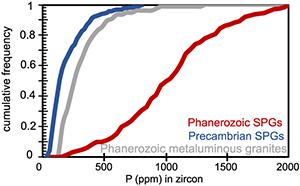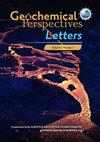锆石磷浓度的长期变化阻止了简单的岩石成因分类
IF 3.7
1区 地球科学
Q1 GEOCHEMISTRY & GEOPHYSICS
引用次数: 0
摘要
根据显生宙辉质花岗岩和过铝质花岗岩锆石中磷含量较低的经验观察,用锆石中的磷(P)浓度来区分它们的来源是辉质花岗岩还是强过铝质花岗岩。显生宙SPGs锆石中较高的P含量反映了过铝熔体中磷灰石溶解度的增强,以及过铝花岗岩中总体较高的P含量。然而,前寒武纪沉积岩部分熔融形成的SPGs的P含量低于显生宙的辉生花岗岩,反映了前寒武纪与显生宙沉积源的P含量较低。研究表明,与显生宙相比,来自前寒武纪SPGs的锆石也具有较低的P浓度,这可能反映了其母代熔体中较低的P浓度。将锆石p -in代入碎屑锆石记录不能有效区分铝质和过铝质来源,也低估了过铝质花岗岩的贡献。虽然碎屑锆石是重要的早期地球档案,但在使用显生宙样品的微量元素代用品时,均变说的观点并不总是适用。本文章由计算机程序翻译,如有差异,请以英文原文为准。

Secular variability in zircon phosphorus concentrations prevents simple petrogenetic classification
Phosphorus (P) concentrations in zircon have been used to discriminate their derivation from metaluminous versus strongly peraluminous granites (SPGs) based on the empirical observation of lower P concentrations in zircon from Phanerozoic metaluminous versus peraluminous granites. Higher P concentrations in zircon from Phanerozoic SPGs reflect enhanced apatite solubility in peraluminous melts and overall higher P concentrations in peraluminous granites. However, SPGs derived from partial melting of Precambrian sedimentary rocks have lower P concentrations compared to Phanerozoic metaluminous granites, reflecting lower P concentrations in Precambrian versus Phanerozoic sedimentary sources. We demonstrate that zircons from Precambrian SPGs also have lower P concentrations compared to Phanerozoic counterparts, likely reflecting lower P concentrations in their parental melts. Applying the P-in-zircon proxy to the detrital zircon record does not effectively discriminate between metaluminous and peraluminous sources and underestimates contributions from peraluminous granites. Although detrital zircons are an important early Earth archive, a uniformitarian perspective cannot always be applied when using trace element proxies developed on Phanerozoic samples.
求助全文
通过发布文献求助,成功后即可免费获取论文全文。
去求助
来源期刊

Geochemical Perspectives Letters
Earth and Planetary Sciences-Geochemistry and Petrology
CiteScore
7.00
自引率
2.00%
发文量
42
审稿时长
15 weeks
期刊介绍:
Geochemical Perspectives Letters is an open access, internationally peer-reviewed journal of the European Association of Geochemistry (EAG) that publishes short, highest-quality articles spanning geochemical sciences. The journal aims at rapid publication of the most novel research in geochemistry with a focus on outstanding quality, international importance, originality, and stimulating new developments across the vast array of geochemical disciplines.
 求助内容:
求助内容: 应助结果提醒方式:
应助结果提醒方式:


